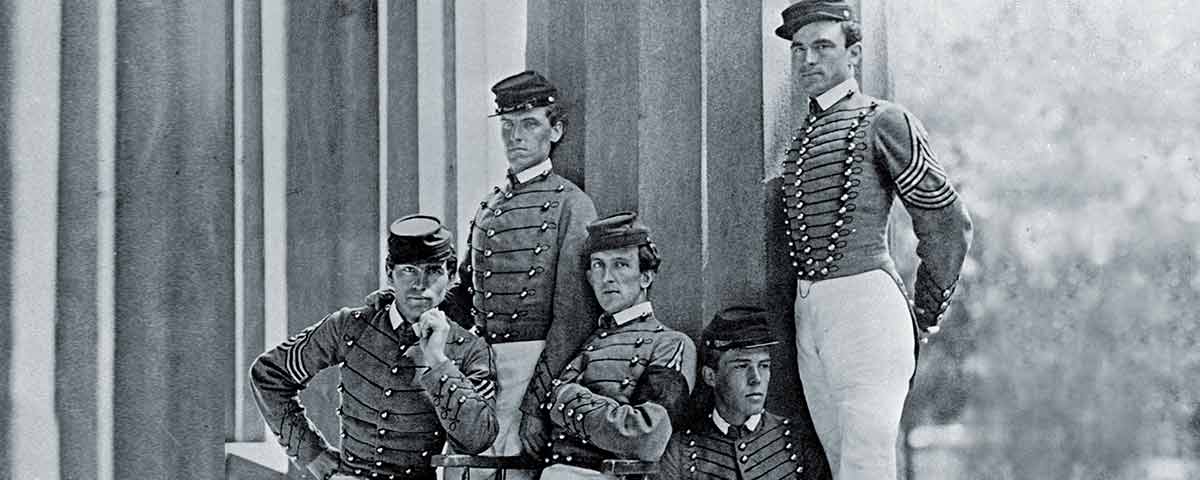
Canadian military officer and historian Ian C. Hope combed through the records of West Point graduates and turned up 1,135 who served the North or the South. He began studying their education and how it influenced the Civil War. He found that about one-third of West Point graduates had prewar military experience, almost one-third served as general officers, and they also commanded most military departments. He gathers his results and how they fit into the history of American military doctrine in A Scientific Way of War: Antebellum Military Science, West Point, and the Origins of American Military Thought (2015).
CWT: Is the West Point education uniquely American?
ICH: Selection into the academy and class ranking within the institution was based strictly upon merit, and not social class or accidents of birth, or birth right. The second unique practice was the requirement that every cadet become competent in all tactical branches; mastering the basics of infantry, artillery, engineering and, eventually, cavalry tactics. The curriculum also provided every cadet with a body of knowledge of ordnance and logistics, military engineering and fortifications, and the science of military movement—or strategy. The last distinct practice was the inculcation in cadets of a sense of duty to federal political masters, and not to the office of a commanding general. This was a very important distinction. West Pointers on both sides understood that their military power served political purpose.
CWT: What advantage does that give?
ICH: Cadets left the academy equally capable of mustering, training and fighting an infantry battalion, an artillery regiment, or a cavalry squadron, and could also perform ordnance functions and duties of a military engineer or topographical engineer. The West Point graduate was a true generalist, useful in the vast variety of circumstances that existed across the United States in the antebellum period.
CWT: What is military science?
ICH: Antebellum military science included three specific branches of learning that each relied upon mathematics. These were—artillery applications, fortifications and engineering, and logistics—the organizing, supplying, encampment and administration of armies. In addition, military science included something called “the science of war” (or what some referred to as “strategy”). This was a common theory used to understand and to plan military campaigns, using common terms such as depots, lines of communication, bases of operation, lines of operation, strategic points, and objective points. Thinking in terms of these elements required knowledge of the particular topography of the region of a campaign, called the “theater of war.” The doctrine of military science used geometric models to portray a variety of options for campaign planning.
[quote style=”boxed” float=”right”]The West Point graduate was a true generalist[/quote]
CWT: What are some outstanding examples?
ICH: Where it becomes really interesting is the point at which the commanders become aware of the advantage of having an alternative base of operations, allowing an army to cut its line of communications to a base, maneuver free and reattach to a separate base—this allowed superb maneuvers for some armies, Grant at Vicksburg, Sherman in Georgia. But Grant’s Overland Campaign demonstrates this best. Grant in Virginia did what Sherman could not in Georgia: switch bases of operation and swivel around the enemy’s flank with great dexterity. Historians later called his operation the Overland Campaign; the fact is that his overland movement was facilitated only because of his use of maritime lines of communication and shoreside bases of operation, just as he had done in Mississippi.
CWT: How do you see this kind of strategy influencing the outcome?
ICH: If the Union did not have Grant and Sherman, with their appreciation of how to maneuver large armies across great distances using alternate bases of operation to outmaneuver Confederate forces, the South might well have won. And in conducting these maneuvering campaigns Grant and Sherman were applying military science that they had first learned at West Point in the antebellum period. Their campaigns became examples for instruction at West Point after the war, perpetuating the doctrine of military science well into the 20th century.
CWT: Which side benefited more from well-prepared officers?
ICH: Both benefited. It is hard to imagine the South lasting so long without the knowledge of Lee, Jackson, and other West Pointers. Generals Jackson, Beauregard, Sherman, etc., were experienced artillery officers of the antebellum Army, who rose to command infantry formations and armies. Grant had served as a regimental quartermaster, so in the Civil War he understood logistics. Sherman had the same experience from California, and Stuart from his days as quartermaster and commissary. Lee—an engineer—had comprehensive knowledge of artillery, infantry, and cavalry tactics because he was inculcated in military science—a “complete system” of knowledge.
CWT: What was surprising to you?
ICH: The clear influence of doctrine and training of officers was not un-
covered before. Too many histories are written using the assumption that performance on the battlefield or in command or armies, was based strictly on innate powers of genius and character. It is also surprising how historians have debated whether the Civil War was the last Napoleonic war or the first modern war. My research tells me that the Civil War was really part of a continuum; and that military science explains better the place of the Civil War in military history.
CWT: Talk about how the military campaigns influenced industrialization.
ICH: In the North, a national logistics system emerged in early 1862 that militarized the Union’s economy in a manner never before experienced or contemplated. It gave enormous powers to the federal government. The quartermaster general became the single biggest employer in the Union, paying over 100,000 employees to make clothing, equipment, and wagons, to purchase horses and mules, and to move large quantities of men and material throughout the North. The long term impact was profound and changed the constitutional relationship between the United States military and the national industry. The centralization that occurred in the North never really went away after the Civil War. ✯
Interview conducted by Senior Editor Sarah Richardson





